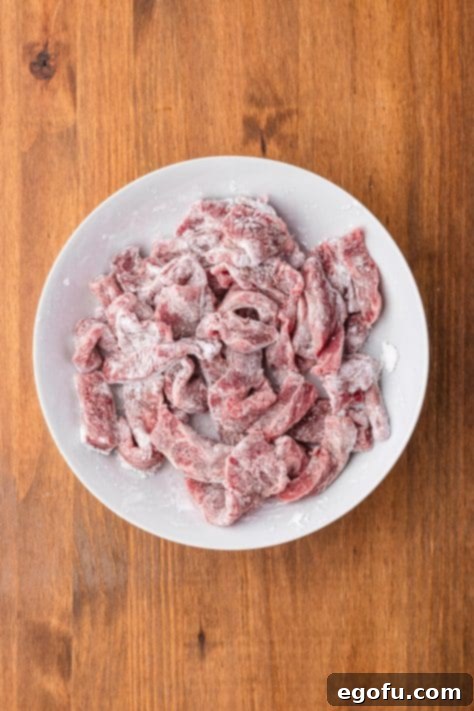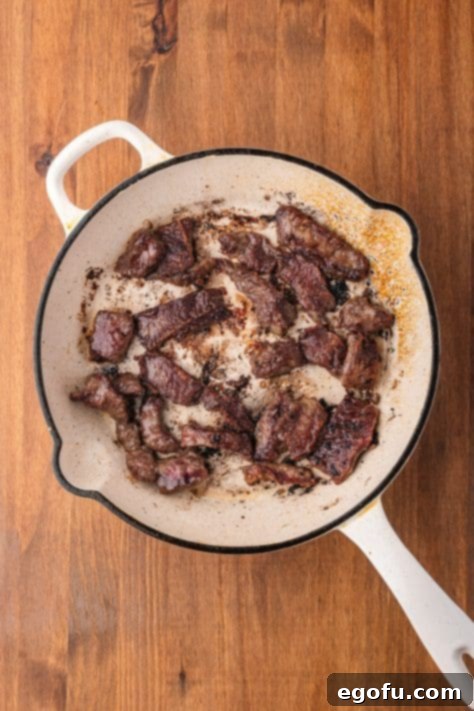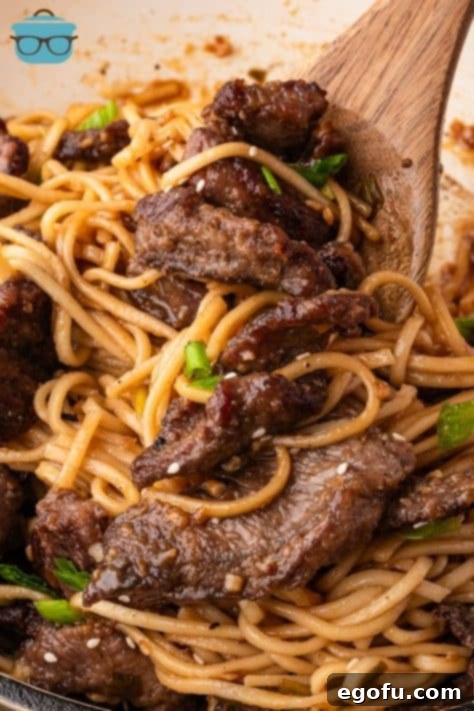Experience the ultimate weeknight convenience with these incredibly easy and flavorful Mongolian Beef Noodles. Crafted in a single pan, this dish brings together succulent pieces of steak, perfectly tender lo mein noodles, and a rich, homemade sweet and savory sauce that will have you reaching for seconds. Forget the takeout menu – this recipe delivers restaurant-quality taste in under 30 minutes!
Effortless Weeknight Wonder: Your 30-Minute Mongolian Beef Noodles Fix
Who doesn’t love the comforting flavors of Mongolian Beef? That perfect balance of sweet and savory, with tender beef and a glossy, rich sauce, makes it a go-to choice when dining out. However, the quality can sometimes be unpredictable. That’s precisely why mastering this dish at home is a game-changer! Imagine creating a consistently delicious version, tailored exactly to your preference, right in your own kitchen – and in less than half an hour. These Mongolian Beef Noodles are not just quick; they’re an explosion of flavor that will impress even the most discerning palates. The homemade sauce is so tantalizingly good, it transforms a simple dinner into a memorable culinary experience that the whole family will adore.
This recipe is designed for busy individuals and families who crave delicious, wholesome meals without spending hours in the kitchen. It simplifies the cooking process without compromising on the authentic taste you expect from a great Mongolian Beef dish. Whether you’re a seasoned chef or a beginner, you’ll find these instructions straightforward and rewarding, culminating in a dish that far surpasses any store-bought alternative. Prepare to add this quick-fix delight to your regular rotation!
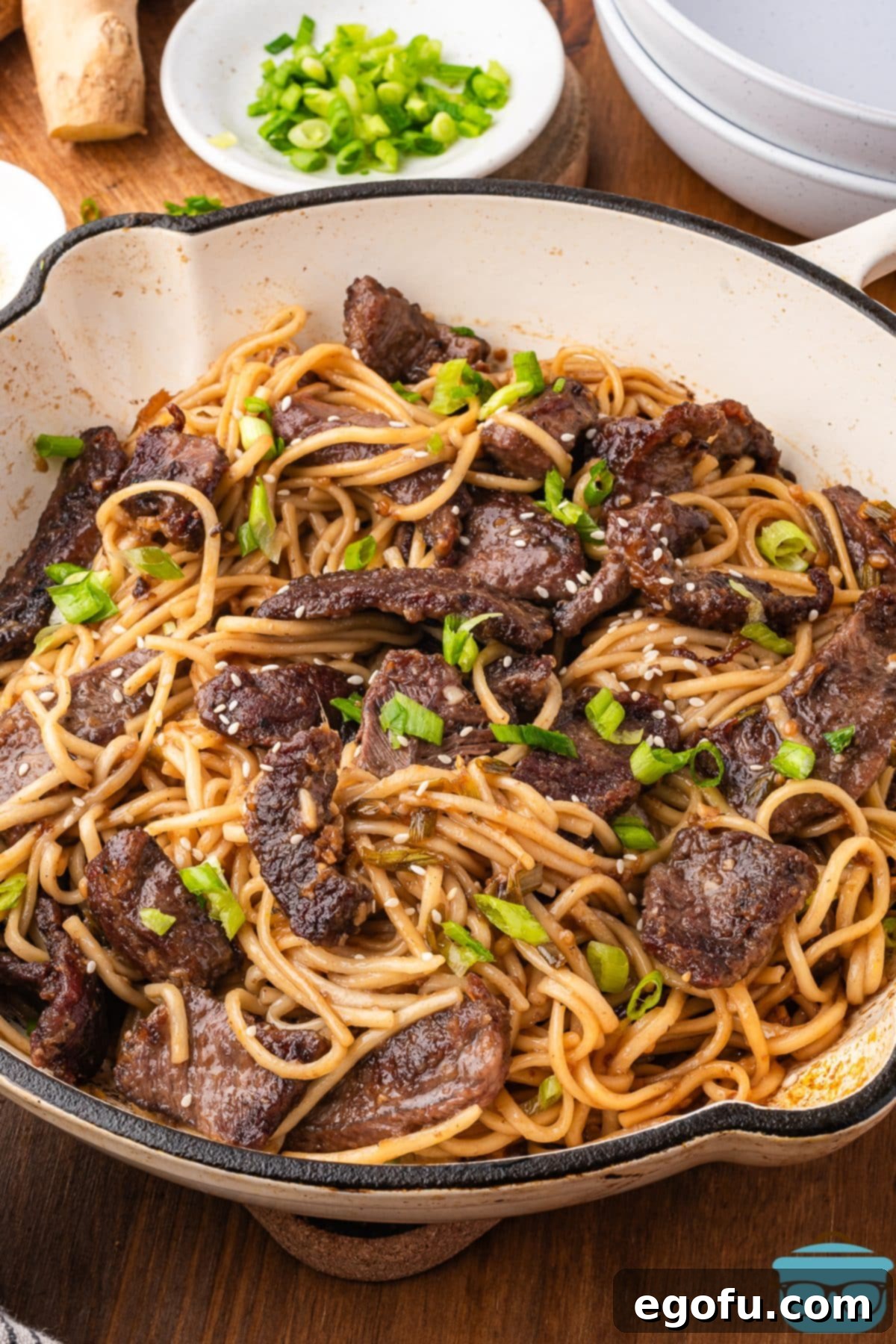
Frequently Asked Questions About Mongolian Beef Noodles
For the most tender and flavorful Mongolian Beef Noodles, I highly recommend using flat iron steak. It’s often more budget-friendly than other premium cuts, while still offering a wonderfully buttery texture when cooked correctly. If flat iron isn’t available or you prefer other options, skirt steak or flank steak are excellent alternatives. The key, regardless of the cut, is to slice the meat thinly against the grain. This technique shortens the muscle fibers, ensuring each bite is incredibly tender and easy to chew, a crucial element for a perfect stir-fry.
Absolutely! This recipe is incredibly versatile. If you’re looking for a meatless option, you can easily omit the steak entirely, letting the rich sauce and noodles shine. Alternatively, you could substitute the beef with other proteins like chicken (sliced thin), shrimp, or even firm tofu for a vegetarian twist. For those who find steak outside their current budget, ground beef works wonderfully as a more affordable and accessible option. Simply brown the ground beef in the skillet, drain any excess fat, and proceed with the recipe as directed. The savory sauce pairs beautifully with various proteins, ensuring a delicious meal every time.
Elevate your Mongolian Beef Noodles with a vibrant array of vegetables! Some fantastic additions include crisp broccoli florets, colorful bell peppers (red, yellow, or orange), sweet snap peas, or thinly sliced carrots. To incorporate them, stir-fry your chosen vegetables after searing the beef and before adding the sauce. This ensures they retain a slight crunch and don’t become overcooked. Feel free to experiment with other stir-fry favorites like mushrooms, bok choy, or water chestnuts for added texture and nutrition.
If you’re a fan of extra saucy noodles, it’s incredibly easy to adjust! Simply double the recipe for the homemade sauce. This will provide a richer coating for your noodles and beef, ensuring every bite is drenched in that delicious sweet and savory goodness. I also recommend adding the beef to the skillet first, coating it thoroughly with the sauce before introducing the cooked noodles. Noodles tend to absorb liquid quickly, so giving the beef a head start ensures it’s equally flavorful and prevents the noodles from soaking up too much sauce too fast.
While lo mein noodles are ideal for their chewy texture and ability to absorb sauce, don’t worry if you don’t have them on hand. This recipe is adaptable to various noodle types. Udon noodles offer a thicker, chewier experience, while rice noodles provide a lighter, gluten-free option. In a pinch, even common pantry staples like spaghetti or fettuccine can work surprisingly well. Just cook them according to package directions until al dente, then rinse and toss with a little oil to prevent sticking before adding them to the sauce.
These Mongolian Beef Noodles are undeniably at their best when served hot, straight from the skillet. The flavors are most vibrant, the noodles are perfectly tender, and the beef is juicy. Serve them in individual bowls, perhaps with an extra sprinkle of fresh green onions and sesame seeds for added visual appeal and a pop of freshness. They make a complete meal on their own, but if you desire a side, a simple cucumber salad or some steamed edamame would complement the rich flavors beautifully.
Absolutely! If you enjoy a little heat in your Asian-inspired dishes, it’s simple to customize the spice level. You can add extra chili sesame oil to the sauce mixture, which will infuse a subtle warmth and distinct flavor. For a more pronounced kick, a squeeze of sriracha sauce or a generous pinch of red pepper flakes can be stirred in during the final stages of cooking. Start with a small amount and taste as you go to achieve your preferred level of spiciness.
Hoisin sauce adds a unique depth to Mongolian Beef, but if you’re out, you have a couple of options. You could proceed with just the soy sauce and brown sugar, though the flavor profile will be slightly different. For a closer match, you can easily whip up a DIY hoisin sauce using common pantry ingredients. Here’s what you’ll need and how to make it:
DIY Hoisin Sauce Ingredients:
3 Tablespoons low-sodium soy sauce
1 Tablespoon smooth peanut butter (trust me, it adds great texture and depth!)
1 Tablespoon light brown sugar
2 teaspoons rice vinegar (or apple cider vinegar)
1 teaspoon sesame oil
1 clove garlic, minced (or 1/4 teaspoon garlic powder)
1/4 teaspoon onion powder
Optional: 1/4 teaspoon Chinese five-spice powder (for authentic flavor)
Optional: 1/2 teaspoon sriracha or hot sauce (for a spicy kick)
Instructions:
In a small bowl, whisk all ingredients together until completely smooth and well combined. Taste the sauce and adjust the sweetness, saltiness, or spice level to your liking. Use immediately in your recipe, or store any leftover homemade hoisin in an airtight container in the refrigerator for up to 1 week.
Leftover Mongolian Beef Noodles are fantastic and reheat beautifully, making them perfect for meal prep. Store them in an airtight container in the refrigerator for up to 3 days. When reheating, you can either warm them gently in a skillet over medium-low heat or use a microwave. I highly recommend adding a small splash of extra soy sauce or a teaspoon of water when reheating. This helps to rehydrate the noodles and sauce, reviving their moisture and flavor, preventing them from drying out. Stir occasionally until heated through.
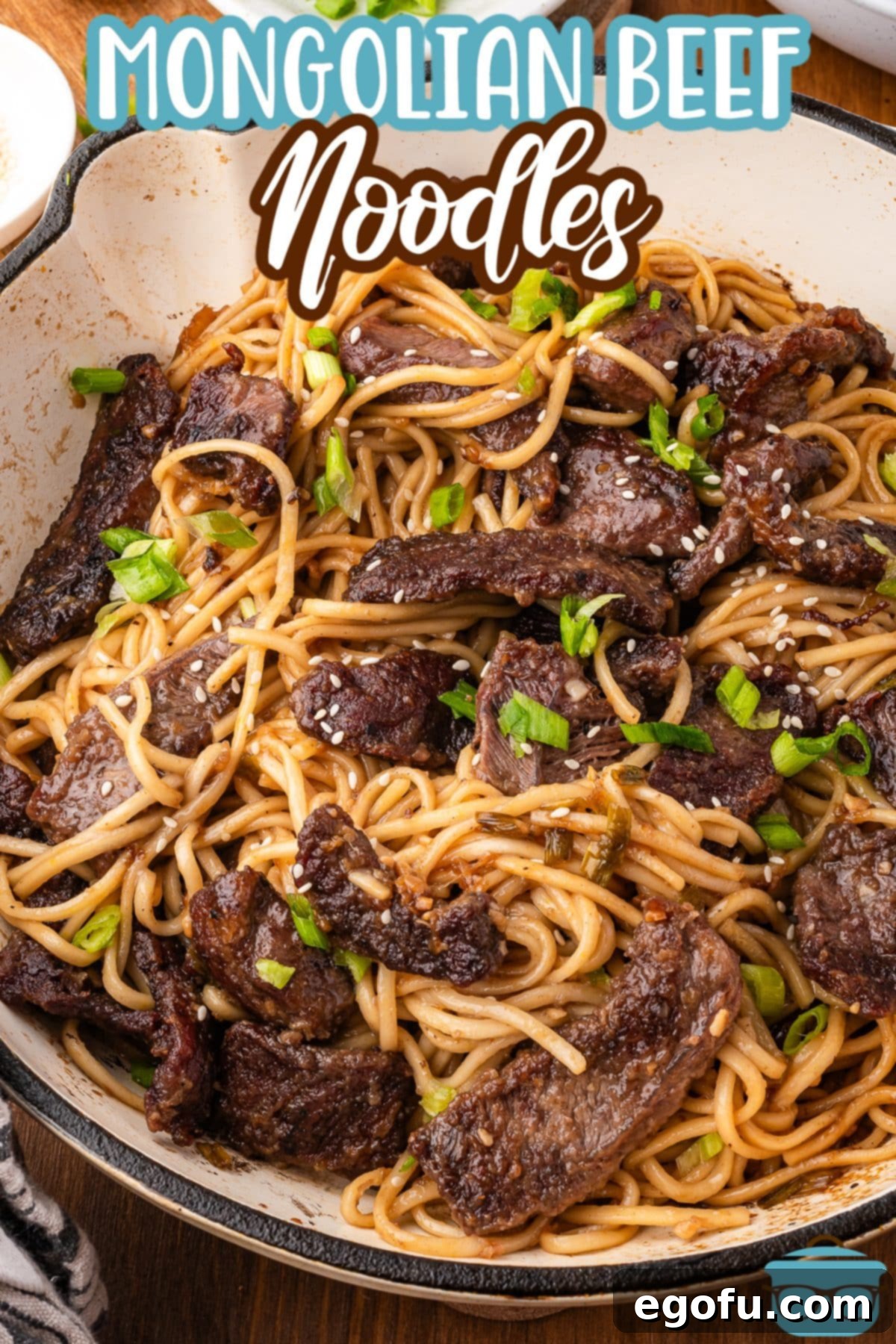
Essential Ingredients for Your Perfect Mongolian Beef Noodles
Crafting these irresistible Mongolian Beef Noodles starts with a selection of fresh, high-quality ingredients. Each component plays a vital role in building the layered flavors that make this dish a favorite. Below is a detailed look at what you’ll need to create this culinary masterpiece at home. (For exact measurements, please refer to the full recipe card below.)
- Lo Mein Noodles: These classic Chinese egg noodles are perfect for stir-fries due to their delightful chewiness and ability to absorb sauces beautifully. If lo mein isn’t available, check our Frequently Asked Questions section above for other excellent noodle substitutes like udon or even spaghetti.
- Flat Iron Steak or Sirloin: As discussed, flat iron steak is my top choice for its tenderness and value. Remember to slice the beef very thinly against the grain. This step is crucial for achieving that melt-in-your-mouth texture that distinguishes a good stir-fry.
- Cornstarch: This serves a dual purpose. First, it creates a light coating on the beef, which helps tenderize it and gives it a slightly crispy exterior when seared. Second, it acts as a thickening agent for the sauce, giving it that luxurious, glossy consistency characteristic of Mongolian Beef. While flour can be used, cornstarch yields a superior texture.
- Vegetable Oil: A neutral-flavored oil suitable for high-heat cooking, perfect for searing the beef and stir-frying. Divided use is important to ensure proper searing of the beef in batches.
- Green Onions: Also known as scallions, these provide a mild onion flavor and a vibrant pop of color. They are used both in the sauce and as a fresh garnish, adding an essential layer of aromatic freshness to the dish.
- Garlic (Minced): Freshly minced garlic is indispensable for its pungent aroma and robust flavor, forming the backbone of the savory sauce.
- Fresh Ginger (Grated): Grated fresh ginger contributes a warm, zesty, and slightly peppery kick that brightens the entire dish. A fantastic time-saving tip is to use the pre-grated ginger found in squeeze tubes, usually located in the produce section of your grocery store. It offers all the flavor without the hassle of peeling and grating.
- Low-Sodium Soy Sauce: Using low-sodium soy sauce is key to controlling the overall saltiness of the dish, especially since other ingredients like hoisin also contribute sodium. This allows you to season the dish to your exact preference without it becoming overly salty.
- Water: Used to thin out the sauce to the perfect consistency, ensuring it coats the noodles and beef evenly without being too heavy.
- Hoisin Sauce: A thick, fragrant Chinese barbecue sauce that provides a wonderful sweet, tangy, and savory umami depth to the Mongolian Beef sauce. If you don’t have any on hand, refer to the detailed DIY hoisin sauce recipe in the FAQ section above!
- Light Brown Sugar: Essential for balancing the savory and salty elements of the sauce, imparting that signature sweet stickiness that defines Mongolian Beef.
- Rice Vinegar: A subtly sweet and mild vinegar that adds a necessary tang and brightness to the sauce, cutting through the richness and enhancing the overall flavor profile. Regular white vinegar can be used in a pinch, though rice vinegar is preferred for its milder acidity.
- Chili Sesame Oil (Optional): For those who enjoy a hint of spice, chili sesame oil adds a wonderful warm, nutty, and subtly fiery note. If you prefer no heat, regular sesame oil will provide a rich, aromatic sesame flavor. If sesame flavor isn’t to your liking, it can be omitted entirely without detracting too much from the dish.

Crafting Your Own Mongolian Beef Noodles: A Step-by-Step Guide
Follow these simple instructions to create a truly unforgettable Mongolian Beef Noodle dish in your own kitchen. This one-pan wonder is designed for efficiency and maximum flavor.
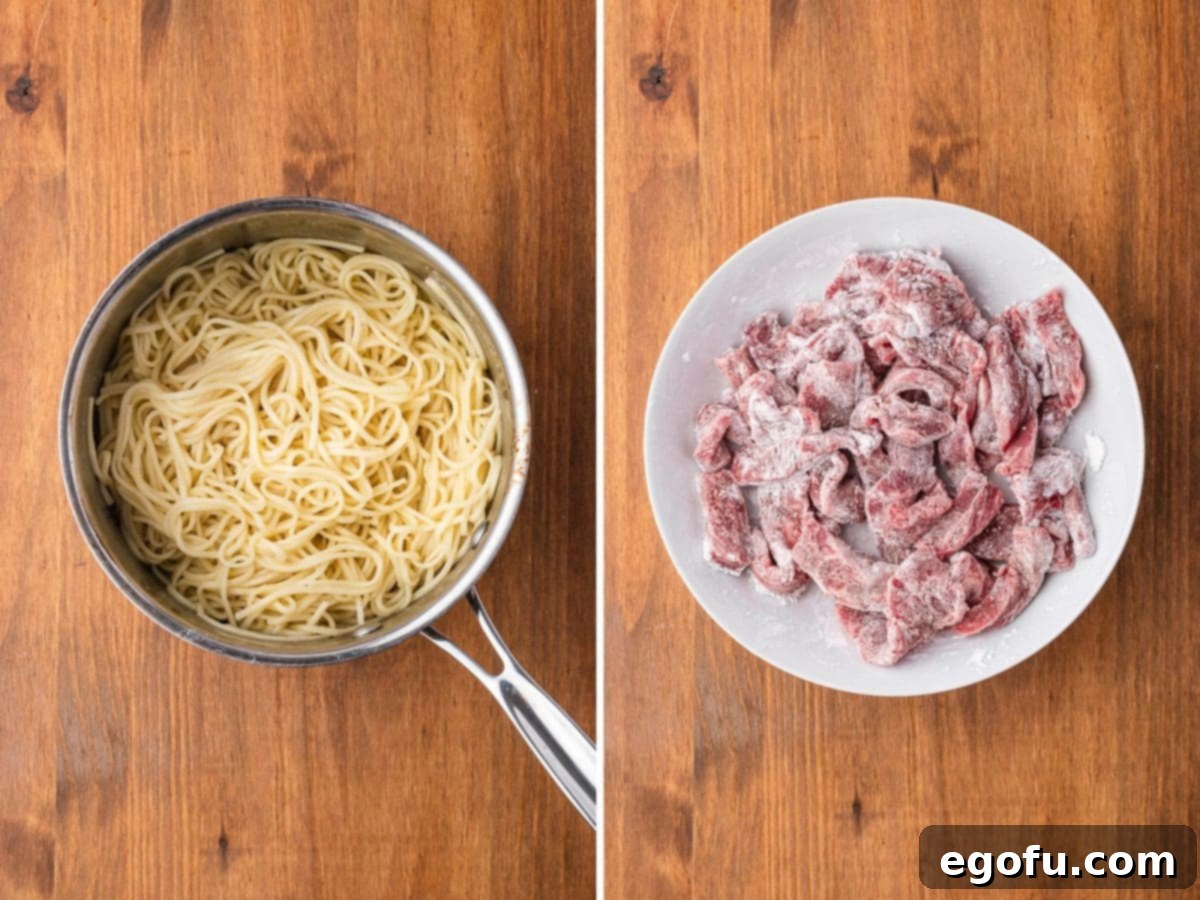
- Prepare the Noodles: Begin by bringing a large pot of water to a rolling boil. Add your lo mein noodles and cook them according to the package directions until they are al dente, tender but still firm. Once cooked, drain the noodles thoroughly and rinse them under cold water. This crucial step stops the cooking process and prevents them from becoming mushy. To keep the noodles from sticking together while you prepare the rest of the dish, drizzle them with a small amount of sesame oil or any neutral cooking oil, and gently toss to coat. Set the noodles aside.
- Coat the Beef: Take your thinly sliced flat iron steak (or sirloin) and place it in a bowl. Sprinkle the cornstarch evenly over the beef slices. Using your hands or tongs, gently toss the beef until every piece is lightly and uniformly coated with the cornstarch. This coating will help tenderize the beef and create a beautiful sear.
- Sear the Beef: Heat a large skillet (or a wok if you have one) over medium-high heat. Add one tablespoon of vegetable oil. Once the oil is shimmering, carefully add half of the cornstarch-coated steak slices to the skillet in a single layer, making sure not to overcrowd the pan. Allow each side to sear for about 1-2 minutes until beautifully browned and cooked through. Remove the seared beef from the skillet and set it aside. Add the remaining tablespoon of oil to the skillet and repeat the searing process with the second batch of beef. Once all the beef is cooked and removed, reduce the heat in the skillet to medium-low.
- Prepare the Sauce: While the skillet is still warm (now on medium-low heat), in a small separate mixing bowl, whisk together the low-sodium soy sauce, water, hoisin sauce, light brown sugar, rice vinegar, and chili sesame oil (if using). Pour this perfectly blended sauce mixture directly into the skillet. Immediately add the minced garlic, grated fresh ginger, and sliced green onions (reserving some for garnish). Allow the sauce to simmer gently for 1-2 minutes, stirring occasionally, until it begins to thicken slightly and the aromatics become fragrant.
- Combine and Finish: Add the cooked lo mein noodles and the seared steak back into the skillet with the simmering sauce. Using tongs or two spatulas, gently toss everything together, ensuring the noodles and beef are thoroughly coated in the rich, glossy sauce. Keep the skillet on the heat for another 1-2 minutes, continuously stirring, allowing the noodles to fully absorb the incredible flavors and for everything to heat through evenly.
- Serve and Garnish: Transfer your glorious Mongolian Beef Noodles into serving bowls. For a final flourish, garnish generously with extra sliced green onions and a sprinkle of sesame seeds (optional). Serve immediately and savor every mouthwatering bite!



Craving More Asian-Inspired Recipes?
If you’ve enjoyed these Mongolian Beef Noodles, you’re in for a treat with these other delectable dishes that bring the flavors of Asia right to your dinner table:
- Beef Fried Rice
- Beef Egg Roll in a Bowl
- Hibachi Steak
- Hibachi Fried Rice
- Chicken Lo Mein
- Chicken Chow Mein Casserole
- Easy Sesame Chicken
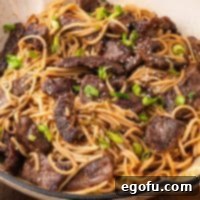
Mongolian Beef Noodles
Print Recipe
Pin Recipe
Rate This Recipe
10 minutes
18 minutes
28 minutes
2
Brandie Skibinski
Ingredients
- 8 ounce package lo mein noodles
- 2 Tablespoons cornstarch
- ¾ pound flat iron steak or sirloin, thinly sliced against the grain
- 2 Tablespoons vegetable oil (divided use)
- ¼ cup low-sodium soy sauce
- 2 Tablespoons hoisin sauce
- ¼ cup water
- 2 Tablespoons light brown sugar
- 1 Tablespoon rice vinegar
- 1 teaspoon chili sesame oil (or regular for no heat – optional)
- 3 cloves garlic, minced
- 1 Tablespoon grated fresh ginger (can use more or less to taste)
- ¼ cup sliced green onions (plus more for garnish)
- sesame seeds (optional, for garnish)
Instructions
- Bring a pot of boiling water to a boil and cook the 8 ounce package lo mein noodles according to the package instructions. Rinse under cold water to stop the cooking process. I recommend drizzling a little sesame oil or neutral oil and toss to coat, so that the noodles do not stick together. Set aside for now.

- Sprinkle 2 Tablespoons cornstarch over the 3/4 pound flat iron steak or sirloin, thinly sliced against the grain and gently toss to ensure all the beef is evenly coated.

- Heat a large skillet over medium-high heat and add one Tablespoon of oil. Place half of the steak slices into the skillet and allow each side to sear, about 1-2 minutes per side. Remove from the skillet and do the same for the next batch, adding the remaining Tablespoon of oil. When all the beef is cooked, remove from skillet and lower the heat to medium-low.

- In a small mixing bowl, whisk together 1/4 cup low-sodium soy sauce, 2 Tablespoons hoisin sauce, 1/4 cup water, 2 Tablespoons light brown sugar, 1 Tablespoon rice vinegar and 1 teaspoon chili sesame oil. Pour this into the skillet then add 3 cloves garlic, minced, 1 Tablespoon grated fresh ginger and 1/4 cup sliced green onions. Allow the sauce to simmer for 1-2 minutes.

- Add the noodles and the steak into the sauce and gently toss everything in the sauce, until well coated. Keep the skillet on the heat for 1-2 minutes and keep stirring.

- Serve in bowls and garnish with extra green onions and sesame seeds.

Notes
- Please refer to my FAQ’s (Frequently Asked Questions) and ingredient list above for other substitutions or for the answers to the most common questions.
Dinner, Main Course
American
Nutrition
Carbohydrates: 112g |
Protein: 46g |
Fat: 34g |
Sodium: 1886mg |
Fiber: 3g |
Sugar: 17g
Nutritional Disclaimer
“The Country Cook” is not a dietician or nutritionist, and any nutritional information shared is an estimate. If calorie count and other nutritional values are important to you, we recommend running the ingredients through whichever online nutritional calculator you prefer. Calories and other nutritional values can vary quite a bit depending on which brands were used.


